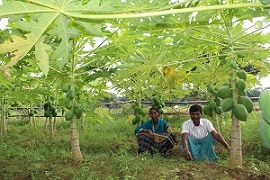Scientific Papaya Cultivation for ensuring Livelihood Security of Tribal Farmers
Scientific Papaya Cultivation for ensuring Livelihood Security of Tribal Farmers
The Papaya being one of the important fruits crops in Jharkhand is mainly grown in the backyard gardens of the houses in the state. Even though, being grown in the homestead and consumed by the farmers, the scientific papaya cultivation is at its infancy among the state’s tribal farmers.
Stakeholders involved
For the purpose of bridging the gap, the Farming System Research Centre for Hill and Plateau Region, Ranchi of ICAR-RCER, in Gumla, Ranchi and Lohardaga district of Jharkhand undertook the technology demonstration on scientific papaya cultivation during 2018-19. The demonstration was carried out under the Tribal Sub Plan of ICAR-All India Coordinated Research Project on Fruits.
To mobilize the tribal farmers, PRADAN (Professional Assistance for Development Action), a NGO working in the field of farm livelihood landed its hand-holding support.
Activities taken up
 Around 8 Extensive Field Training along with exposure visits of the tribal farmers on scientific papaya cultivation were undertaken before planting. About 1,300 tribal farmers were imparted the training.
Around 8 Extensive Field Training along with exposure visits of the tribal farmers on scientific papaya cultivation were undertaken before planting. About 1,300 tribal farmers were imparted the training.
The technology demonstration with papaya varieties namely - Red Lady, NSC 902 and Ranchi Local was undertaken in more than 600 tribal farmers’ fields (30,000 plants). Due its hardness, comparatively less susceptibility to pest and diseases the farmers were mainly growing Ranchi Local variety in the backyard gardens. But, at the same time being dioeciously in nature, only 50% - 60% plants produce fruits. To resolve the problem, the technology demonstration on “Planting of three seedlings per pit and removal of male plants after initiation of flowering” was undertaken in the farmers’ fields. This practice gave 80% - 90% fruiting plants and ultimately increased the production by 30% - 40% over the traditional method of planting of Ranchi Local variety.
Smt. Roopvanti Didi of Village Dubang of Lohardaga District planted 45 papaya plants of variety - Ranchi Local as per the above recommendations in an area of nearly 200 m2. With this, she obtained 38 fruiting plants and started selling vegetable purpose papaya after the plants attained 5 - 7 Months of age. She sold around 65% of her produce as vegetable papaya with net income of Rs. 8,550/- and rest of the produce as ripe fruits with net income of Rs. 7,400/- after 10 - 13 Months of planting. So, she earned a total of Rs 15, 950/- by the cultivation of papaya variety - Ranchi Local.
The demonstration of micro-nutrient application, especially, boron application (0.3%) was also carried out among the farmers. The boron application (4 sprays) minimized the flower and fruit drop to the tune of 22% - 35% and increased the yield up to 15% - 20%, irrespective of the varieties. In order to limit the spread of the Papaya Ring Spot Virus (PRSV), a major disease in the region through the vector, the integrated approach was followed by planting of disease free seedlings, avoiding the virus host plants like cucurbits and solanaceous vegetables near papaya field, uprooting of weeds and spray of neem oil at monthly interval and use of systemic insecticides. This approach helped in minimizing the PRSV incidence up to 50% - 60%.
Impact of the technology
This initiative proved to be a real helping hand in boosting the farmers’ income to the range of Rs. 1,200/- to Rs. 1,75,000/- depending upon the area under cultivation and management practices adopted. This initiative worked as a catalyst in inspiring the other farmers in the nearby villages towards papaya cultivation.
Considering the demand of the planting material and looking at the opportunity of entrepreneurship development among the tribal farmers, it was decided to promote papaya nursery rising in the region through participatory mode. For this, around 16 progressive farmers from the Gumla and Lohardaga Districts were imparted the training on “Improved Papaya Nursery Raising”. The trainees were provided with the necessary inputs like poly bags and papaya seed under the Tribal Sub Plan of ICAR-AICRP on Fruits.
More than 28,000 papaya seedlings were produced and sold by the trained papaya nursery growers to nearly 1,000 farmers of Lohardaga and Gumla Districts during the Months of April - May, 2020. By selling the plants at an average rate of Rs. 10 per plant, the entrepreneurs could earn an average profit of Rs. 12,000/- in a period of 3 Months.
The additional income from the nursery particularly, during the lockdown period due to the outbreak of COVID-19 has been a boon for the farmers. Further, the profit earned by the papaya growers under the programme has acted as eye opener for the other tribal farmers of the area as well. The Government of Jharkhand has also started promoting the papaya cultivation among the tribal farmers under the different State and Centrally Sponsored Schemes during last 2 Years. It is hoped that scientific papaya cultivation with hand-holding of scientific Institutions can prove to be an effective income generation activity for the migrant laborers of the Districts in the forthcoming years.
Source : ICAR
Last Modified : 6/23/2021
This topic provides information about Overview of ...
Provides information related to the district Initi...
Provides information about Virtual Responsive Smar...
This topic provides information about Cost Effecti...
